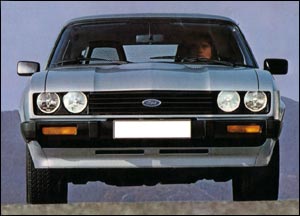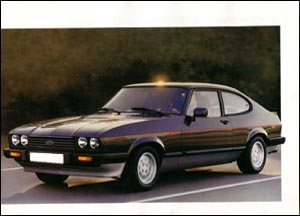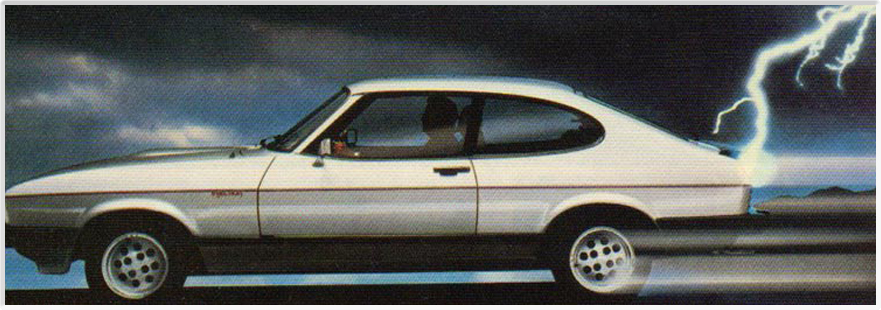
 Club Update Club Update |
 Our next gathering is scheduled for Tuesday, 21st January, 2025, at the Matthew Flinders Hotel, Dinner from 6pm. Our next gathering is scheduled for Tuesday, 21st January, 2025, at the Matthew Flinders Hotel, Dinner from 6pm. |
 Note: Updates are also posted on our Club Facebook page at Capri Car Club Note: Updates are also posted on our Club Facebook page at Capri Car Club |

| Ford Capri Mark 3 | ||||||||||||||||||||||||||||||||||||||||||||||||||||||||||||||||||||||||||||||||||||||||||||||
|
The Capri Mk3 was referred to internally as "Project Carla", and although little more than a substantial update of the Mk2, it was often referred to as the Mk3. The first cars were available in March 1978, but failed to halt a terminal decline in sales. The concept of a heavily facelifted Capri 2 was shown at the 1976 Geneva show: a Capri 2 with a front very similar to the Escort RS2000 (with four headlamps and black slatted grille), and with a rear spoiler, essentially previewed the model some time before launch. The Mk3 featured improved aerodynamics, leading to improved performance and economy over the Mk2 and the trademark quad headlamps were introduced.
At launch the existing engine and transmission combinations of the Capri 2 were carried over, with the 3.0 S model regarded as the most desirable model although in truth the softer, Ghia derivative with automatic rather than manual transmission the bigger seller of the two V6 engined models.
The 3.0 S was used extensively in the TV series The Professionals, with characters Bodie driving a silver 3.0 S and Doyle a gold 3.0 S, which was credited with maintaining interest in the car in the UK. Ford began to focus their attention on the UK Capri market as sales declined, realizing the car had something of a cult following there. Unlike sales of the contemporary 4 door Cortina, Capri sales in Britain were to private rather than fleet buyers who would demand less discounts, allowing higher margins with the coupé. Ford tried to maintain interest in 1979 with "X Pack" options from the performance oriented "Rallye Sport", or "RS" parts range. Although expensive and slow selling these proved that the press would enthusiastically cover more developed Capris with higher performance. In 1981, the 3.0 V6 powerplant was dropped from the line-up, while a new sporty version debuted at the Geneva Motor Show, called the 2.8 Injection. The new model was the first regular model since the RS2600 Capri to use fuel injection. Power rose to 118 kW giving a top speed of 210 km/h (130 mph), but the car still had a standard four-speed gearbox. The Capri 2.8 Injection breathed new life into the range and kept the car in production 2-3 years longer than Ford had planned. The four-speed gearbox was replaced with a five-speed unit early on at the same time Ford swapped the dated looking chequered seats for more luxurious looking velour trim. A more substantial upgrade was introduced in 1984 with the Capri Injection Special. This development used half leather seating and included a limited slip differential. Externally the car could be easily distinguished by seven spoke RS wheels (without the customary "RS" logo since this was not an RS vehicle) and color coded grille and headlamp surrounds. At the same time the 2.0 L Capri was rationalized to one model the 2.0 S, which simultaneously adopted a mildly modified suspension from the Capri Injection. The 1.6 model was also reduced to one model, the 1.6 LS. Although the Capri no longer had a racing career, Ford of Germany developed a limited edition, left hand drive only, turbocharged model with 140 kW, which could propel the car to 220 km/h (137 mph) in April 1982. This wild looking derivative featured widened bodywork and "RS" badging of the engine and wheels. Although rare and collectible it was not regarded as a car of equal stature to the later Tickford - the other Ford "official" turbo Capri. The Tickford Capri used the 2.8 Injection (rather than the RS model which strangely used the Granada carburettor engine) and developed 205 hp (153 kW) this version also featured a luxury interior with optional full leather retrim and Wilton carpeting and headlining, large rear spoiler, color coded front grille, deeper bumpers and 'one off' bodykit designed by Simon Saunders, later of KAT Designs and now designer of the Ariel Atom. The independent tuner Turbo Technics also released a 200 hp (149 kW) version, and a new 230 hp (172 kW) evolution which came supplied with a specially built gearbox. The Tickford Capri pricing issues meant that Ford also sanctioned the Turbo Technics conversion as semi-official, although only the German RS and British Tickford ever appeared in Ford literature as official Ford products. Rear disc brakes were standard on the Tickford which featured numerous other suspension modifications. This model was essentially rebuilt by hand by Tickford at approximately 200 hours per car, several of those dedicated to reshaping the leading edge of the bonnet to mate with the redesigned grille and body kit. It's still regarded as one of the most collectible Capri models today although at the time it struggled to sell even 100 units, despite extensive research and development costs. One problem was the relative price difference to the standard Capri Injection. To put this in perspective, the cost of the basic car doubled which would translate to a 30,000 coupé, such as a BMW 3 Series, being sold at 60,000 or BMW M3 money. From November 1984 onwards, the Capri was sold only in Britain, with only right hand drive cars were made from this date. The 1.6 and 2.0 variants were rebranded with a new trim level "Laser" which featured a fully populated instrument pod, leather gear lever, leather steering wheel and an electric aerial along with colour-coded grille and mirrors. The last run limited edition "Brooklands" Green, 280 model, featuring a limited slip differential, full leather Recaro interior and 15 inch versions of the seven spoke 13 inch wheels fitted to the superseded Capri Injection Special. Ford originally intended to make 500 turbo charged vehicles (by Turbo Technics) complete with gold alloy wheels and name it the Capri 500 but a change of production planning meant a name change to Capri 280 as the cars were simply the last models ran down the production line. A total of 1,038 Capri 280s were built. Contrary to some reports these cars were not called "Capri 280 Brooklands", the latter name of the famous Surrey race track only being applied to the paint colour rather than the car itself. When the last Capri was made on December 19, 1986, 1,886,647 cars had rolled off the production line. Production had ended at Halewood, UK in 1976 and the Capri was made exclusively in Germany from 1976 to 1986. Most of those (more than a million) were the Mk 1, mostly because the Mk 1 sold well in North America and Australia, while the Mk 2 and Mk 3 were only exported outside Europe (to Asia and New Zealand) in limited numbers. The Capri is remembered for the classic advertising slogan "The car you always promised yourself". A North American advertising campaign featured a shorter line: "Capri: The Sexy European".
| ||||||||||||||||||||||||||||||||||||||||||||||||||||||||||||||||||||||||||||||||||||||||||||||

 |
||||||||||||||||||||||||||||||||||||||||||||||||||||||||||||||||||||||||||||||||||||||||||||||












